Hot newsthe latest news here for you!
An old renovated house near to the oldest places of the Greek-Roman culture in the Calabrian Jonian coast.
"We don’t fall in love only with people. There are places that come into our heart and don’t leave it anymore. I discovered that crumbling ruin in Martiri lane by chance and I was very impressed from it.
I tried to convince the owner of the old house to sell it to me for years; it was like a long flattery but at the end I had it! And I had a very clear idea in my mind since the beginning: to make of those old walls a meeting place, a little oasis of peace, a starting point from which to leave for discovering my village.
Torrent’s stones, blocks, shingles’ scraps, clay little bricks are the things that have been used to build what today is the Amphisya B&B.
The way has been long: the house was very ruined so it was impossible to renovate it and many people suggested me to destroy it and to build a new house. But I didn’t want to demolish two centuries of history written by fishmen, peasant and farmers.
In those walls, where there was an oven, bread had been cooked, the ground floor was a stable and that little area of fishmen’s houses was so lively! All this was so important to me that I had to try to renovate the house… So, thanks to the suggestions of a “capomastro”- the main construction worker, the art of a worker of Bivongi, (which with I went to stole the stones from the river), the simple and delicate touch of my wife and the intuition of my son, the B&B began to take shape.
Everything in the B&B is calabrian: the wooden beams are from Fabrizia, a village of Serre Mountains; the roof tiles are old; the granite, used for the windows and the balconies, had been used also for building the gate of the rich houses. The old floor, recycled in a little part, has been used for the landing while the balconies in wrought-iron have been made by a smith of Gioiosa. The power economy by solar panels, air conditioning and the free use of bike give to the Amphisya B&B a modernity touch that offers to our customers the sensation to feel good also in holiday like in own house. This is our story.”
Enzo.
Game fishing (tourist fishing excursions)
Amphisya B&B offers to its customers the opportunity to make fish hunting on boat with professional fishermen and with the best equipment in the today’s trade.
Vincenzo Muscolo, a known fisherman and official testimonial of important brands in the fish world, will go with you during exciting spinning, vertical jigging, eging sessions and more. www.vincenzomuscolo.com
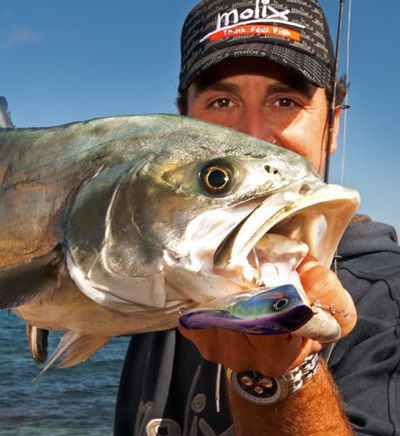
Vincenzo Mari, trawler fishing and drifting Italian champion, instead, will go with you to look for coastal predator fishes and the big red tuna.
Lido il Gabbiano [Amphisya's Partner]
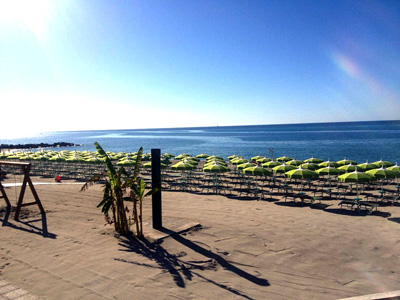
Follow Il Gabbiano on Facebook
Web: www.lidoilgabbiano.it/
Fitwalking at Roccella Jonica

Calabria Fitwalking
Fausto Certomà
Squadra Sportiva Calabria Fitwalking - Facebook
forecast about local weather conditions

Roccella Jonica has very old origins, that probably date back to the Magna Grecia time. The village, indeed, is the ancient place called Amphisya by the latin poet Ovidio in his poems. In the X century the village is called already Rupella, then Aroccella, until the actual name of Roccella for its position on a rock.
The first document that testifies the existence of Roccella dates back to the 1270: it’s the sell of the Castle by Carlo I d’Angiò to Gualtieri de Collepietro.
Roccella was an important fortress in the defence of the cost from the Saracen invasion as the heraldic banner symbolizes, representing a warrior that fights against a Moor.
Today, the Castle is the first thing that a traveler notices arriving to Roccella, because it dominates all the village from the rock in which is located.
In the town centre there are many interesting buildings like Englen Palace (today Tassone Palace), built probably in the XVIII century. It is one of the most impressive buildings in the village and it belonged to the Englen’s noble family, moved to Roccella at the end of XVII century from Acquaro d’Arena (CZ).
Placido Palace is another interesting building; built probably in XVIII century, it’s on three levels. At the ground floor is a little patio with a nice fountain and on the façade is a great portal in sculpted stone.
Other interesting buildings are: Villa Alicastro, Villa Carafa, Palazzo Congiusta.
In addition to the monuments, you can get the history of Roccella going through the lanes of the “Borgo”, the high part of the village, where there are many examples of the rural culture (typical houses, oil mill, ect) or visiting the sea burgs as Zirgone e Sant’Antonio. The popular traditions are valued every year by many feasts to which people takes part in a very active way.
Among the itineraries, we suggest you to make that along the north part of the rock’s slope from Via Torrente Zirgone to the Castle. The route is easy thanks to stairs and leaves from the stream where the Madonna delle Grazie’s Sanctuary rises.
Along this itinerary, you can see in a splendid natural frame, the Teatro al Castello, in which every year important shows take place as the famous International Jazz Festival “Rumori Mediterranei” .
To visit also San Nicola Church (ex Aleph), the Matrice Church, the two monolithic columns.
The beautiful sandy beach attracts many tourists from every part of Italy.
2016 new flags:
Bandiera Blu - 5 Vele Legambiente

Buildings of historical relevance
Palazzo Baudille
Palazzo Congiusta
Palazzo Englen
Palazzo Placido
Palazzo Rossetti
Palazzo Ursini
Villa Carafa
Villa Alicastro
Traditions and events
Maria S.S. delle Grazie Feast
Every year, the first Sunday of the july there is the feast in honor of the Virgin “Maria S. S. delle Grazie”, patron of the fishermen of the village. It’s a feast that attracts many people and that arises in 1545 when a fisherman, Onofrio Buscemi, received a miracle and to thank the Virgin built a Sanctuary to her. During the week of the feast there are three processions but the best is that on the boat, where the Virgin is brought followed by many little boats of fishermen, blessing the sea.
Roccella Jazz festival
Since more of 30 years during the summer, Roccella Jonica receives an important festival of Jazz music (its first edition goes back to the 1980) known as “Roccella Jazz Festival – Mediterranean Sounds” with very famous artists of every part of the world. Since 2007 it began to make concerts also in other towns of the vicinity, even though Roccella remains the main and most important place of the festival.
"The White Night"
Every year, from the night of 14 August to the morning of the 15, Roccella is animated by several entertainments: shows, concerts, food feast ect. As conclusion “Back to Flora”, remembering the disco on the beach of 70s and 80s, that was the attraction of all the Ionian coast and that unfortunately a sea storm destroyed.
Other events
"FESTA DI SAN VITTORIO MARTIRE" - Second Sunday of August.
"FESTA DELLA MADONNA ADDOLORATA"- Third Sunday of September
"NCRINATA 'I PASCA"- Easter morning
"BALLO DEL CIUCCIO" - 4 of August
Useful links
Calabria Terra di Festival - Risorsa online sugli eventi calabresi
MUSABA - Parco Museo Laboratorio all'aperto - Mammola (Rc)
*
Sources: Wikipedia - Sito Comune di Roccella Jonica
by Monica 2011 - Trip Advisor
Semplicemente meraviglioso. "Bellissimo B&B nel borgo di Roccella. Camere nuove dotate di tutti i confort; colazione abbondante e ottima (tutte le mattine torte fatte in casa, fichi, merendelle, cornetti ripieni, ecc.). I padroni di casa cordiali ed ospitali; le biciclette a disposizione fuori casa".
The first room that you meet on the balcony, at the first floor. Large and bright double room with roof made of wooden beams. The window looks at Ruga Grande, discovering the soul of the old town.
The second room on the balcony at the first floor. Very large and bright double room, it can become triple or quadruple room depending on the needs. Roof with wooden beams and very cute balcony, open on the old little lanes of the town.
The only single room of our B&B. The third door on the balcony at the first floor. Comfortable and very refined room. Wooden roof also in the bathroom and window that looks at the inner balcony.
The first room on the ground floor. Cool and quite, it opens the door on the lush patio of the house and the window on the lanes of the old town.
The second room on the ground floor. Very large and cool. It opens the door in the inner part of the B&B and the window on the lanes of the old town, the “rughe”. Many years ago, it hosted the animals of the house, it was the stable.
| PRICE LIST | |||||||
Room Tipology |
from 01 October to 31 May |
from 01June to 30 June |
from 01 July to 31 July |
from 01August to 31 August |
from 01 September |
Extra bed | |
|---|---|---|---|---|---|---|---|
| Double/Twin Room | 60 € | 70 € |
80 € | 100 € |
70 € | 15 € | |
Single Room |
35 € | 40 € | 45 € | 55 € | 40 € | - - | |
The rate indicated at the moment of the booking includes taxes. The customer must communicate in useful time a telephone number and the arrival time to arrange the check-in. The check-in time is from 12,00 am and the check-out time is within 10.30 am of the departure day. The deposit of luggage the day of the departure is free. Read more...
Cash
Bank Transfer
Cheque
* Children 0-4 years: free
The price must be intended per room and per night, breakfast included.
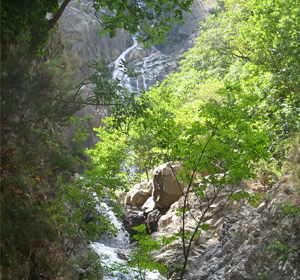
Roccella Jonica is a famous tourist place that offers long sandy beaches and a very clear sea, but it’s also a very good starting point for naturalistic excursions on the surrounding mountains, as it is at few minuts from Serre and Aspromonte Mountains. So we suggest you to take advantage and visit very interesting naturalistic places.
Check availability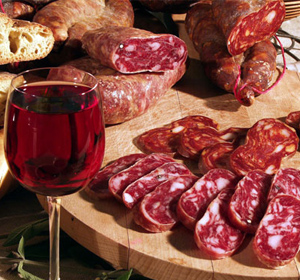
The Calabrian gourmet culture is known in the whole world. From the hot salami called ‘Nduja to the fish prepared according to the ancient local recipes, we know what to eat and where to go for tasting the realest Calabrian cooking.
Check availability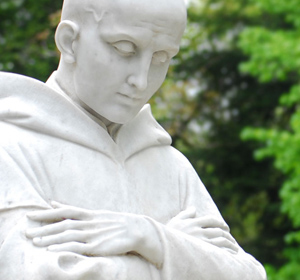
Calabria has always been land of cult and religiousness, for this reason there are many old churches, abbeys, monasteries etc hidden in the beautiful sceneries of the Calabrian mountains.
Check availabilitymoving from B&B Amphisya